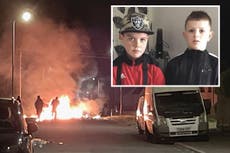The Independent's journalism is supported by our readers. When you purchase through links on our site, we may earn commission.
I’m a criminologist – this is why the Cardiff riots blew up
I spend much of my time speaking to perpetrators about their lives and what they think lies behind the worst of their behaviours

Your support helps us to tell the story
From reproductive rights to climate change to Big Tech, The Independent is on the ground when the story is developing. Whether it's investigating the financials of Elon Musk's pro-Trump PAC or producing our latest documentary, 'The A Word', which shines a light on the American women fighting for reproductive rights, we know how important it is to parse out the facts from the messaging.
At such a critical moment in US history, we need reporters on the ground. Your donation allows us to keep sending journalists to speak to both sides of the story.
The Independent is trusted by Americans across the entire political spectrum. And unlike many other quality news outlets, we choose not to lock Americans out of our reporting and analysis with paywalls. We believe quality journalism should be available to everyone, paid for by those who can afford it.
Your support makes all the difference.In the aftermath of the riots in Ely, Cardiff this week, some social commentators took to Twitter to point the finger at a range of societal ills that they felt played their part in the build-up to the collective violence.
Claims of “deprivation”, “distrust” in authorities and “disillusionment” with the future rang out across social media. Counterarguments pointed at the role of the police, with rumours circulating online alongside CCTV footage, that suggested a pursuit of two young local boys just before their tragic deaths.
As a criminologist, it is my job to understand the causes and consequences of criminal behaviour. I spend much of my time speaking to perpetrators about their lives and what they think lies behind the worst of their behaviours.
Most recently, I have been preoccupied with the motivations of people who violently attack others because of their difference, widely known as hate crime perpetrators. What I have learnt from speaking with these people is also useful for understanding what happened in Ely this week.
A lot of hate crime is conducted by groups of mostly young white men. They either set out to violently target a person or persons different to them, or come across a random opportunity to do so. These groups of perpetrators are, more often than not, unemployed or on low incomes, frustrated with their circumstances, and with the authorities who they see as favouring everyone but themselves and their “in-group”. Their victims are scapegoats – containers for their wider frustrations who they see as deserving targets.
These frustrations are likely felt by many who took part in the riot earlier this week. But given the national energy crisis, cost-of living squeeze and widespread declining confidence in the police, we have to ask the question: why haven’t we seen more rioting up and down the country if these grievances are the motivation? Research into the 2011 England riots pointed to similar social problems at the time, but also emphasised the key role played by “flashpoints” or “trigger events” in igniting these “accelerants”.
“Trigger events” also play a central role in hate crimes. We have seen political votes, court cases and terror attacks all act as ignitors of underlying social accelerants. These result in significant (but temporary) surges in the number of people taking to the streets and social media to commit physical and virtual violence against minority groups.
As with hate crimes, rioting is also highly dependent on these “flashpoints” – moments in time where something happens to ignite the touchpaper. In the riot earlier this week, it was the rumour on social media that a police chase was linked to the tragic death of Kyrees Sullivan (16 years old) and Harvey Evans (15).
In that moment, the rumours, whether verified or not, likely meshed with longer-term local grievances with the police, and other state institutions which they represent in the eyes of the mob, creating the ideal conditions for violent disorder.
For that disorder to spread to such a large number of people also required a shared sense of social identity to emerge in the rioting “in-group”, that was reinforced by its direct opposition to an “out-group”; in this case the police “aggressors” who were perceived to play a role in the death of the two local boys. Much like in hate crime perpetration, beyond the immediate set of circumstances, the police acted as containers for the wider frustrations of the rioting mob.
In the same way that positive contact between in-groups and out-groups reduces hate crimes, building trust between local communities and police would reduce the chances that a “flashpoint” resulted in collective violence.
To reduce those chances even further will require those in power to deal with the wider social problems responsible for the deep frustrations felt by the disaffected.
Matthew Williams is a criminologist at Cardiff University, and the author of The Science of Hate: How prejudice becomes hate and what we can do to stop it, published by Faber & Faber


Join our commenting forum
Join thought-provoking conversations, follow other Independent readers and see their replies
Comments